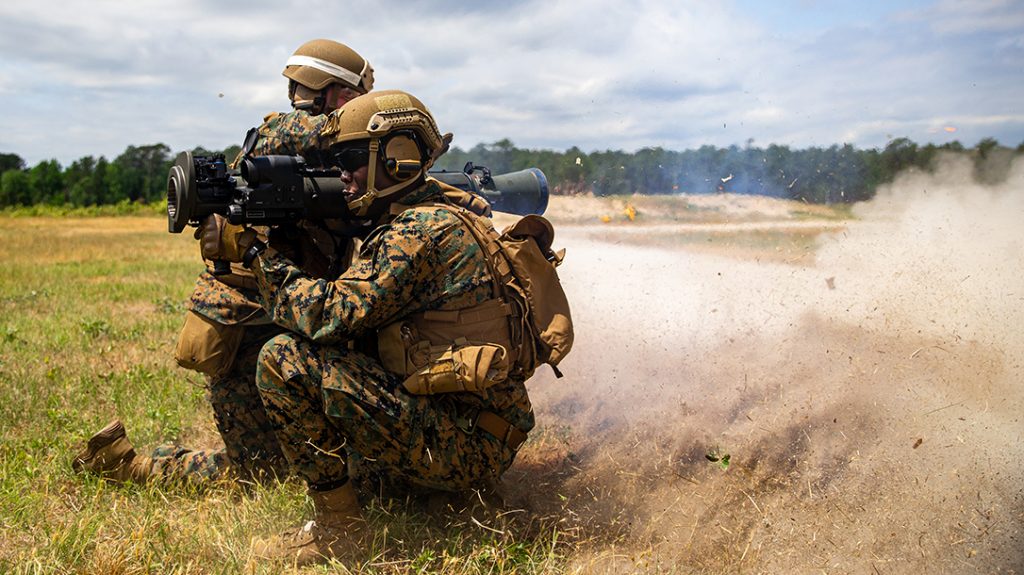Marines have begun receiving a new, explosive rocket launcher that provides additional protection and lethality in urban environments–the MAAWS.
Marine Corps MAAWS Recoilless Rocket
In May, Marine Corps Systems Command began fielding the M3A1 Multi-Role Anti-Armor Anti-Personnel Weapons System to infantry Marines in Camp Lejeune, North Carolina. The MAAWS is a reloadable, recoilless rocket system intended to supplement existing shoulder-fired rocket capabilities.
“The MAAWS is a reusable, long-range weapon that provides the capability to destroy armored vehicles, structures and fortifications, which will be useful for infantry Marines,” said Capt. Christopher Adsit, MCSC’s project officer for the MAAWS.
Advertisement — Continue Reading Below
The system consists of the M3A1 Carl Gustaf Recoilless Rifle, an Aimpoint fire-control system and a backup reflex sight Marines can use if the primary optic malfunctions. It includes munitions that provide obscuration, illumination, anti-personnel, armor penetration, bunker- and hardened-facility penetration, and other destruction capabilities.
“It has the ability to fire [illumination], smoke and airburst-style rounds,” said CWO4 David Tomlinson, MCSC’s infantry weapons officer. “The capability will allow the warfighter to engage the enemy in defilade, reinforced bunkers and buildings.”
Upgrading the Battlefield
The MAAWS is augmenting the Mk153 Shoulder-Launched Multipurpose Assault Weapon, a rocket system initially fielded to Marines in 1984 before undergoing several modifications in the 2000s. The Marine Corps has used the SMAW to destroy armored vehicles, bunkers and other fortifications.
Advertisement — Continue Reading Below
However, the MAAWS can engage enemies at farther distances when compared with the SMAW. The MAAWS can also hit moving targets with the aid of its fire control system. It increases the accuracy and overall lethality of infantry squads.
Adsit said the MAAWS will also supplement the explosive power of the M72 Light Anti-Tank Weapon, a portable, one-shot anti-tank weapon. The additional rounds available to the MAAWS increase a squad’s options for target engagement.

Advertisement — Continue Reading Below
“This new rocket system shoots farther than any of our current shoulder-launched rocket systems,” said Adsit. “It significantly increases the shoulder-fired rocket range.”
Marines Take the MAAWS Afield
Earlier this year, new equipment, live-fire training events at the Schools of Infantry East and West enabled nearly 100 Marines to test the weapon. The MAAWS was well-received among participating Marines, including Sgt. David Beggel, a squad leader with 1st Battalion, 2nd Marine Regiment.
“When we do urban operations, we carry a rocket because you don’t know what kind of enemy we’ll have, what capabilities they’ll have,” said Beggel. “This gives us a wide range of opportunities and assets that we can use to destroy a vehicle or take out [the enemy].”
Advertisement — Continue Reading Below
Increasing the lethality of Marines helps the Marine Corps meet future force design goals. Tomlinson said the overall capabilities of the MAAWS allows platoons to operate in more dispersed environments, supporting Commandant of the Marine Corps Gen. David Berger’s vision for lower-level units to control more battlespace area.
“The MAAWS is important because it gives the squad an enhanced capability with increased lethality and will bring a greater combined-arms solution to the enemy,” said Tomlinson. “The rocket system will change the way the infantry squad fights.”
Tomlinson said all Fleet Marines will receive the MAAWS by the end of 2023 and Reserve Marines by 2024. He projects every Marine Corps battalion to have the weapon in their arsenal by 2025.
Advertisement — Continue Reading Below
Story by Matt Gonzales (Marine Corps Systems Command); Video by Cpl. Hassanen Attabi (3rd Marine Division).
























